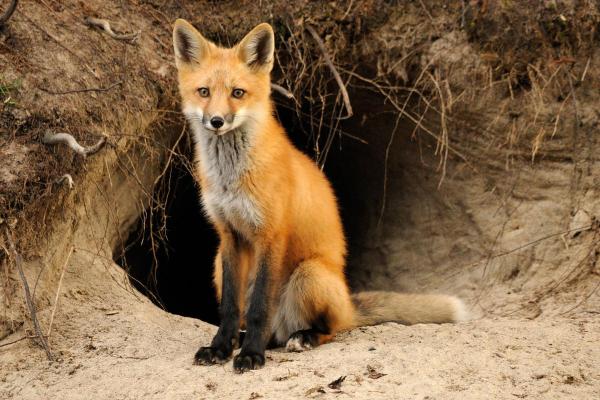Do foxes lay eggs or give birth?


The birth of young animals is an amazing sight, providing insight into the amazing adaptations that each species has to offer. To ensure that their progeny flourish in the wild, they engage in a complicated ballet of behavior and biology during their intriguing reproductive trip.
This AnimalWised article delves into the fascinating science of fox reproduction. We'll explore everything from the meticulous selection of birthing dens to the incredible journey of fox pups, from conception to their first steps of independence. Along the way, we'll uncover the captivating physiological and anatomical processes that make this miracle of life possible.
Do foxes lay eggs or give birth?
Foxes give birth because they are carnivorous mammals that belong to the family Canidae, alongside wolves and dogs. Unlike birds, reptiles, and other creatures that lay eggs, foxes are mammals. This means their bodies are specially designed for internal development of their young.
One key feature distinguishes mammals from egg-laying animals: mammary glands. These glands produce milk, a vital source of nourishment for young mammals after birth. This nurturing characteristic sets mammals apart. Egg-laying animals, also known as oviparous, reproduce by laying eggs. These eggs, common among birds, reptiles, and some fish, contain yolk, a built-in food source for the developing embryo. The egg itself is usually protected by a shell or membrane to ensure the embryo's survival.
The fox's reproductive system, like other mammals, is a complex network of internal and external organs. These organs work together for the production and delivery of gametes (sperm and eggs) as well as the nurturing of offspring.
The female's system consists of ovaries, fallopian tubes, a uterus, and a vagina. During the estrous cycle, the ovaries produce eggs, which travel to the fallopian tubes. If fertilization by sperm occurs, the fertilized egg implants itself in the uterus for development. The uterus provides a nourishing environment until birth.
The male fox has testes that produce sperm, transferred to the female during mating. The penis serves as the organ for sperm delivery during copulation.
What makes a mammal? Delve deeper into the defining characteristics of placental mammals, including foxes, in our article on the secrets of mammal life.

How do foxes reproduce?
Fox reproduction is a fascinating process driven by both biological adaptations and clever behaviors. Here's a breakdown of the key steps:
Estrus:
The breeding season, or estrus, for most fox species typically falls within the winter months, ranging from December to February. During estrus, female foxes advertise their receptivity to mates through the emission of chemical signals and vocalizations.
Courtship:
Males, driven by reproductive imperatives, engage in elaborate courtship behaviors to woo potential mates. These rituals may involve persistent following of the female, allogrooming (fur maintenance), and playful displays of submission or playfulness. These acts serve a dual purpose: impressing the female and establishing a bond that fosters successful mating.
Mating and gestation:
Following successful courtship, copulation occurs. The copulation process itself can last several minutes and may be repeated over multiple days to ensure fertilization. After copulation, the female fox undergoes a gestation period, typically lasting between 50 and 60 days depending on the species. During this critical time, the fertilized egg develops into an embryo within the mother's uterus.
Parturition:
As spring approaches, pregnant vixens (female foxes) seek out safe and secluded dens or burrows for parturition (giving birth). The arrival of the kits typically occurs between March and May, although this timing can vary based on the species and environmental factors. A typical litter may consist of 4 to 6 pups, but the exact number can fluctuate based on factors like food availability and the mother's health.
The reproductive process outlined above serves as a common thread across many fox species. However, it is important to acknowledge variations in reproductive behavior between different species and geographic regions. Some fox species may exhibit distinct courtship behaviors, social structures, and even levels of monogamy. For instance, some species may have a more extended breeding season or exhibit less commitment to a single partner.
Uncover the diversity of the fox family in our article exploring the world of fox breeds.

When do foxes reproduce?
Fox mating primarily occurs in late winter, typically between December and February. While this timeframe can vary slightly depending on the specific geographic location and environmental conditions, it generally ensures that the fox kits are born in early spring.
Fox kits are typically born in early spring, usually in March or April. This timing aligns with the warmer weather and increased availability of prey, providing optimal conditions for the growth and development of the young foxes.
It's essential to note that fox reproduction is not a uniform process across all species. Different fox species exhibit variations in their reproductive seasonality, adapting to their specific habitats and ecological niches. For example:
- Red Fox (Vulpes vulpes): this iconic species typically mates during the winter months, aligning with the traditional late winter mating season observed in many foxes.
- Gray Fox (Urocyon cinereoargenteus): the gray fox may have a more extended breeding cycle, potentially occurring throughout the year in some regions.
Furthermore, it's crucial to recognize that these reproductive patterns can be influenced by a combination of factors, including species-specific behaviors, environmental conditions, and human impact.
Discover the diverse diet of foxes in our article.
What is fox pregnancy like?
The fox pregnancy, also known as gestation, typically lasts between 49 and 58 days, with an average of 52 days. This is around 7.5 weeks or just under two months.
Unlike some canines that dig their own dens, foxes exhibit opportunistic denning behavior. They readily utilize abandoned badger dens, woodchuck burrows, or even natural cavities like hollow logs or rock crevices. This adaptability allows them to find suitable birthing and rearing locations across diverse habitats.
Fox reproduction exhibits a degree of cooperative breeding. The male fox (dog) plays a vital role during gestation. He actively provisions the vixen (female fox) with food and may even participate in den guarding, ensuring her safety and the kits' well-being during this vulnerable period.
Fox vixen fertility can vary depending on factors like food availability and overall health. Litter sizes typically range from 2 to 12 kits, with an average of 4-6. This allows them to capitalize on abundant resources while ensuring enough offspring survive to maturity.
How do you know if a fox is pregnant?
Spotting a pregnant fox is tricky. Look for weight gain, especially around the belly, and swollen mammary glands in late pregnancy. They may also become more secretive and focus on finding a den in late winter/early spring. Remember that it is crucial to observe from afar to avoid disturbing them.

How are foxes born?
After a gestation period, the vixen will give birth to a litter of fox kits (babies). Fox kits are born blind and deaf. They are also quite small, weighing only around 100 grams (3.5 ounces) and covered in short, dark fur.
The vixen will stay with the kits in the den for several weeks, nursing them and keeping them warm. The dog will also play a role by bringing food for the vixen during this time. Over the next few weeks, the kits will begin to develop rapidly. Their eyes and ears will open, their fur will become thicker and more reddish, and they will start to explore their surroundings outside the den.
By around 6-8 weeks old, the kits will be weaned from their mother's milk and begin to eat solid food brought back by the parents. They will continue to learn hunting and survival skills from their parents until they are old enough to be independent.
How long does a mother fox stay with her pups?
By around 5-7 months old, the pups will be fully weaned and independent enough to disperse and find their own territories.
Dive deeper into the fascinating world of these cunning canines with our article on remarkable fox facts.

If you want to read similar articles to Do foxes lay eggs or give birth?, we recommend you visit our Facts about the animal kingdom category.
- Farstad, W. (1998). Reproduction in foxes: current research and future challenges . Animal Reproduction Science, 53(1-4), 35-42.
- Cavallini, P., & Santini, S. (1995). Timing of reproduction in the Red fox, Vulpes vulpes . Zeitschrift fur Saugetierkunde, 60(6), 337-342.
- Angerbjörn, A., Hersteinsson, P., & Tannerfeldt, M. (2004). Arctic foxes . The biology and conservation of canids. OUP, Oxford, 163-172.
- Eide, NE, Jepsen, JU, & Prestrud, P. Å. L. (2004). Spatial organization of reproductive Arctic foxes Alopex lagopus: responses to changes in spatial and temporal availability of prey . Journal of Animal Ecology, 73(6), 1056-1068.
- Cavallini, P., & Santini, S. (1996). Reproduction of the red fox Vulpes vulpes in Central Italy . In Annales Zoologici Fennici (pp. 267-274). Finnish Zoological and Botanical Publishing Board.









